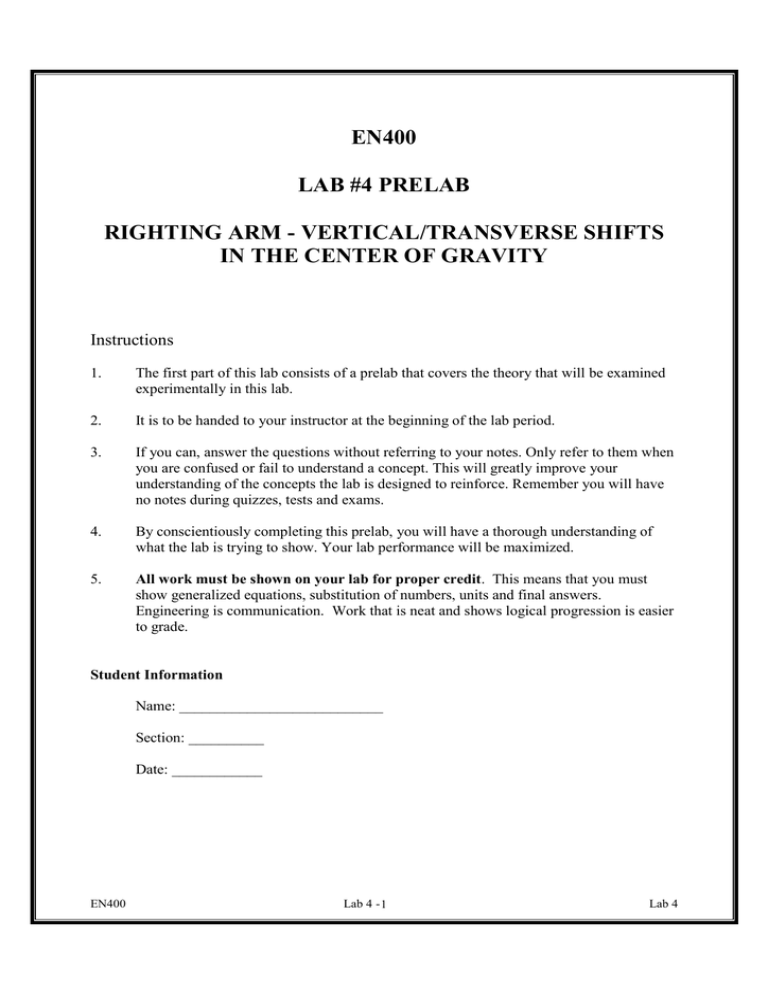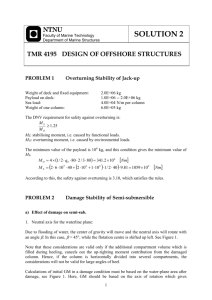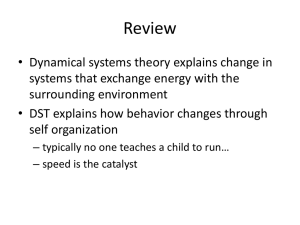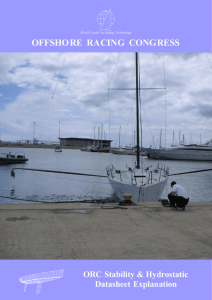EN400 LAB #4 PRELAB RIGHTING ARM - VERTICAL/TRANSVERSE SHIFTS
advertisement

EN400 LAB #4 PRELAB RIGHTING ARM - VERTICAL/TRANSVERSE SHIFTS IN THE CENTER OF GRAVITY Instructions 1. The first part of this lab consists of a prelab that covers the theory that will be examined experimentally in this lab. 2. It is to be handed to your instructor at the beginning of the lab period. 3. If you can, answer the questions without referring to your notes. Only refer to them when you are confused or fail to understand a concept. This will greatly improve your understanding of the concepts the lab is designed to reinforce. Remember you will have no notes during quizzes, tests and exams. 4. By conscientiously completing this prelab, you will have a thorough understanding of what the lab is trying to show. Your lab performance will be maximized. 5. All work must be shown on your lab for proper credit. This means that you must show generalized equations, substitution of numbers, units and final answers. Engineering is communication. Work that is neat and shows logical progression is easier to grade. Student Information Name: ___________________________ Section: __________ Date: ____________ EN400 Lab 4 - 1 Lab 4 Part 1:Prelab Theory 1. The 27-B-1 model is going to be heeled by the presence of an external force, in this case the force in the wire (Fwire). This force (Fwire) is actually part of a moment couple, its equal and opposite partner being the force on the pin preventing the model from translating in the tank (Fpin). 2. You will recall that a couple is a particular type of moment defined as: “.... a pair of equal and opposite forces separated by a distance” 3. a. What is the effect of a moment on a body? _____________________________ b. What are the units of a moment? ______________________________________ When the 27-B-1 is heeled to a particular angle by Fwire you will find that it remains at that heel without further rotation or translation. Is the model in static equilibrium? Why? _________________________________________________________________ ______________________________________________________________________ 4. Figure 1 is a simplified diagram of the 27-B-1 model heeling in the tank. a. b. EN400 On the figure show the location and direction of the 2 forces Fwire and Fpin . Give the equation for the magnitude of the external moment created by these forces in terms of the quantities on the Figure. Lab 4 - 2 Lab 4 Wire G WL Figure 1 View of Model N Simplified Heeling Rdisc Pin B 5. Hull of the model Circular disk CL Since the model is in static equilibrium at each angle of heel, there must be an equal and opposite moment being created by the model. This moment is being created by the 2 resultant forces due to the model’s displacement (S) and its buoyant force (FB). a. b. c. On Figure 1, show the location and direction of the 2 forces S and FB. Show the righting arm between these 2 forces. Call this distance GZ. Give the equation for the magnitude of the internal moment created by these forces in terms of the quantities on the Figure. 6. Assuming the model is at static equilibrium, derive the equation that links the internal and external moments above. 7. Derive an equation that can be used to calculate the internal righting arm being developed by the model (GZ). EN400 Lab 4 - 3 Lab 4 8. Using this apparatus and the equation above it will be possible to find the righting arm being developed by the 27-B-1 model at any angle of heel indicated on the protractor. The plot of righting arm, GZ against angle of heel is termed the curve of intact statical stability. 9. Use Figure 2 to plot the curve of static stability (starboard heels only) for a ship with the following stability characteristics. Ensure to label all axes. a. b. c. d. Range of stability Angle of maximum righting arm Maximum righting arm Righting arm at 30o of heel = = = = 0 - 88o 50o 3.5 ft 2.0 ft Figure 2 - Graph for Plotting Curve of Static Stability 10. EN400 In this lab, the center of gravity of the ship will be shifted vertically and then horizontally. The effect of these shifts on the stability of the model will calculated and then determined experimentally. Lab 4 - 4 Lab 4 11. EN400 To show you understand the geometry of the heeling conditions sketch the model in the following conditions and heeling angles. Your sketches should include the center of buoyancy (B), center of gravity (G), the displacement, the buoyant force (FB), the angle of heel (), the waterline and the righting arm (GZ) whenever applicable. Normal Condition, 0º of heel Normal Condition, 45º heeling angle TCG to Stbd, 45º of heel to stbd TCG to Stbd, 45º of heel to port Lab 4 - 5 Lab 4 Figure 3 - The Heeling Ship with a Vertical Shift in the Center of Gravity 12. Use Figure 3 to derive an equation for the new righting arm (G1Z1) after a vertical shift in the center of gravity from G0 to G1. Your equation should include the old righting arm (G0Z0) and the angle of heel (). 13. From your answer above, what effect do you believe an increase in the distance KG will have upon the stability of a ship? ___________________________________________ _____________________________________________________________________ 14. EN400 In the next portion of the lab, the center of gravity of the ship will be shifted transversely. The effect this has upon the curve of intact statical stability will be measured. It should be possible to predict this effect by an analysis of the heeling ship shown in Figure 4. Lab 4 - 6 Lab 4 Figure 4 – The Heeling Ship with a Transverse Shift in the Center of Gravity 15. Use Figure 4 to derive an equation for the new righting arm (G1Z1) after a transverse shift in the center of gravity from G0 to G1. Your equation should include the old righting arm (G0Z0) and the angle of heel (). IMPORTANT!! Before you can start the lab, you will need the information you acquired from the Inclining Experiment (Lab 4) concerning the 27-B-1 model you are working with. Remember you should use the same 27-B-1 model for all your EN400 laboratories Find the light and KGlight you calculated from Lab 3. EN400 Lab 4 - 7 Lab 4 (THIS PAGE INTENTIONALLY BLANK) EN400 Lab 4 - 8 Lab 4 EN400 LAB #4: RIGHTING ARM - VERTICAL AND TRANSVERSE SHIFTS IN THE CENTER OF GRAVITY Instructions 1. This lab is conducted in the Hydromechanics Lab on the ground floor of Rickover Hall. 2. You will need to bring this handout to the lab. You must also have recorded the KGlight found in the Inclining Experiment lab in the appropriate cell of the table on p10. 3. The lab is to be performed in small groups of 2 or 3. Your instructor will specify whether the group or each individual must submit the completed lab. 4. Another way the learning experience of the lab can be destroyed is by failing to follow the stages of the lab consecutively. The lab follows a logical thought pattern, jumping ahead without doing the intervening theory questions will limit your understanding. 5. All work must be shown on your lab for proper credit. This means that you must show generalized equations, substitution of numbers, units and final answers. Engineering is communication. Other people should be able to understand your work. 6. Keep your workstation (including the floor) clean and dry. Ensure all equipment and the models are returned to their original location when you complete the lab. Student Information: Name:__________________________ Date:____________________ 1st Partner_______________________ 2nd Partner___________________________ EN400 Lab 4 - 9 Lab 4 Part 2: Procedure Apparatus 1. Before beginning the experiment, ensure the 27-B-1 model number corresponds with the number on the solid floored tank, the protractor and the tank. This should be the same as the model used in the Inclining Experiment - Lab 3. 27-B-1 model number = ______________________ Light-ship Condition 2. The first step is to ensure the model 27-B-1 is in its light-ship condition. This is achieved by the following: a. b. c. Ensure all detachable weights are off the model (4 x 0.2 lb weights and protractor device). Ensure there is no loose water within the central compartment. Ensure the solid floored tank with its flooded side down is securely installed in the center compartment. Normally Loaded Condition 3. The model must then be loaded to achieve its normally loaded condition. All quantities concerning the model can then have the suffix ‘normal’ once it has been loaded. The load consists of the following. a. b. 4. EN400 Inclinometer. 4 x 0.2lb weights mounted on the center post. Complete the table below and load the model so that it is in its normally loaded condition. Light-ship Condition light (lb) KGlight (in) Inclinometer wprotractor (lb) Kgprotractor (in) 4 x 0.2 lb Weights w4 x 0.2 (lb) Kg4 x 0.2 (in) Normally Loaded Condition normal (lb) KGnormal (in) Lab 4 - 10 Lab 4 Curve of Static Stability for Normally Loaded 27-B-1 Model 5. The stability lab can now begin. Perform the following steps: a. Make sure all the weights and inclinometer are secure on the model. Also ensure the hatch cover is correctly fastened. You are going to capsize the model, you don’t want water entering the central compartment. Float the model in its normally loaded condition so that its pins are inserted in the grooves on the tank. Connect the wire from the circular disc to the force gauge making sure it passes around the groove in the circumference of the plate. With the wire in a slack condition (Fwire = 0 lb), make sure the model is floating upright. Alter the locations of the transverse weights to achieve this. Zero the force gauge and ensure the metallic button is depressed during the entire experiment. b. c. d. e. 6. You can now begin to heel the model to starboard, recording the force Fwire at 5 degree increments. Ensure you note the angle at which the model capsizes. Starboard Measurements Angle of Heel (Degrees) EN400 Force in the Wire Fwire (lb) Starboard Measurements Continued Righting Arm GZ (in) Lab 4 - 11 Angle of Heel (Degrees) Force in the Wire Fwire (lb) Righting Arm GZ (in) Lab 4 Righting Arm After Vertical Rise in G 7. A vertical change in the Center of Gravity can now be created by inverting the solid floored tank within the central compartment. Invert the tank and re-assemble the model including all its weights. 8. The effects of a rise in Center of Gravity can be calculated prior to starting the experiment. Given wtank = 2.2 lb, Kgtank before the inversion was 3 inches, after the inversion it is 5 inches, calculate the KGvertical Remember to show the generalized equation first, substitute your data and then calculate. 9. Now determine the expected righting arm for this vertical change in gravity by completing the table below. Angle of Heel (Degrees) Normally Loaded Righting Arm, G0Z0 (from step 6) (in) Sine Correction Term (in) Corrected Righting Arm, G1Z1 (in) 0 15 30 45 EN400 Lab 4 - 12 Lab 4 10. Repeat the process you performed earlier to find the curve of static stability. Use the table below to record the data. (Record only what the instruments tell you, you should not be influenced by the calculated values obtained earlier.) Ensure you note the angle at which the model capsizes. Starboard Measurements Angle of Heel (Degrees) 11. Force in the Wire Fwire (lb) Starboard Measurements Continued Righting Arm GZ (in) Angle of Heel (Degrees) Force in the Wire Fwire (lb) Righting Arm GZ (in) Comment upon any differences between the calculated data points for the inverted righting arm with those found experimentally.__________________________________ _______________________________________________________________________ 12. Has this proved or disproved the accuracy of the sine correction? ___________________ Why? __________________________________________________________________ EN400 Lab 4 - 13 Lab 4 Righting Arm after a Transverse Shift 13. Now the model can be moved into its transversely loaded condition. Give the model a starboard list by moving the 4 x 0.2 lb weights to the starboard post. All quantities concerning the model can then have the suffix ‘trans’ once these weights have been shifted. Leave the floor in the inverted position. 14. Record the initial angle of list below. Remember starboard angles are positive, port angles are negative. Initial Angle of List (Degrees) 15. The effects on stability of a transverse shift in the Center of Gravity can be calculated prior to the collection of data. Calculate the new TCG after a weight shift. 16. Now determine the expected righting arm for this transverse shift in the center of gravity by completing the table below. Angle of Heel (Degrees) Righting Arm From Vertical Shift G1Z1 (from step 10) (in) Cosine Correction Term (in) Corrected Righting Arm G2Z2 (in) 0 15 30 45 EN400 Lab 4 - 14 Lab 4 17. Complete the following table for the transverse shift using the same procedures as before. However, in this section, the model will be heeled to both starboard and port. For the port measurements, the model will need to be reversed in the tank. (Record only what the instruments tell you, you should not be influenced by the calculated values obtained earlier.) Ensure you note the angle at which the model capsizes. Starboard Measurements Angle of Heel (Degrees) EN400 Force in the Wire Fwire (lb) Port Measurements Righting Arm GZ (in) Lab 4 - 15 Angle of Heel (Degrees) Force in the Wire Fwire (lb) Righting Arm GZ (in) Lab 4 18. Comment on any differences between the calculated data points for the corrected righting arm with those found experimentally. _________________________________ _______________________________________________________________________ 19. Has this proved or disproved the accuracy of the cosine correction? _________________ Why? __________________________________________________________________ Summary 20. Using your experimental data from all three conditions, complete the following table. Condition Normally Vertical Shift Transverse Transverse Loaded (Stbd Shift Shift (Stbd heeling) heeling) (Stbd heeling) (Port heeling) Range of Stability (Deg) Maximum Righting Arm (in) Angle of Max GZ (Deg) 21. What deduction can you make regarding the effect of an increase in KG on the stability of a ship?_______________________________________________________________ _______________________________________________________________________ _______________________________________________________________________ 22. What deduction can you make about the overall stability of a ship when heeling in the direction of a transverse weight shift?_________________________________________ _______________________________________________________________________ _______________________________________________________________________ 23. What deduction can you make about the overall stability of a ship when heeling away from the direction of a transverse weight shift?__________________________________ _______________________________________________________________________ _______________________________________________________________________ 24. Plot all the experimental and calculated data in Excel. Include the normal, vertical shift, and transverse shift (port and starboard) heeling conditions. Ensure each curve is clearly labeled. Remember to label your axis and title your plot correctly. EN400 Lab 4 - 16 Lab 4






